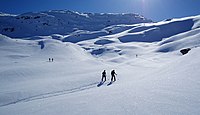
Photo from wikipedia
ABSTRACT Biomechanical differences in double poling (DP) between sex and performance level were investigated in female and male cross-country skiers during a classical race (10/15 km). Skiers were divided into… Click to show full abstract
ABSTRACT Biomechanical differences in double poling (DP) between sex and performance level were investigated in female and male cross-country skiers during a classical race (10/15 km). Skiers were divided into faster and slower on basis of race performance: females faster (n=20), females slower (n=20), males faster (n=20), and males slower (n=20). Based on video analysis while DP in a flat section of the track, joint and pole angles at pole plant (PP) and pole-off, cycle characteristics and the use and coordination pattern of heel-raise (raise of heels from the ground to have a higher body position at PP) were analysed. Faster females and males had 4.3% and 7.8% higher DP velocity than their slower counterparts (both P<0.001). Faster males had 6.5% longer cycles than slower males (P<0.001). Faster skiers stopped heel-raise later than slower skiers (females: 2.0±3.4% vs. −1.0±3.5%, P<0.05; males: 3.9±2.4% vs. 0.8±3.2% of cycle time in relation to PP, P<0.001). At PP, faster skiers and male skiers had a smaller pole angle and greater ankle to hip and ankle to shoulder angle with respect to vertical, resulting in a more distinct forward body lean. However, the majority of the differences are likely due to higher DP velocity.
Journal Title: Journal of Sports Sciences
Year Published: 2019
Link to full text (if available)
Share on Social Media: Sign Up to like & get
recommendations!